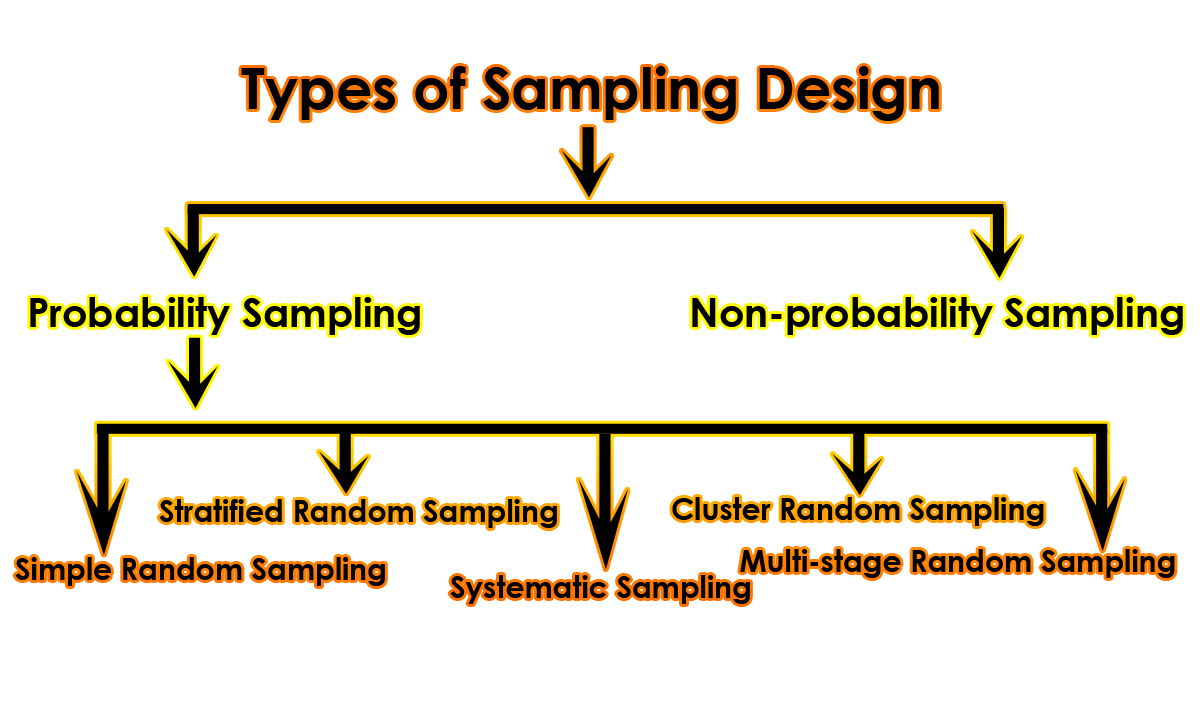A sampling design is definite plan for obtaining a sample from a given population. It refers to the technique or the procedures the researcher would adopt in selecting items for the sample. Sample design may as well lay down the number of items to be included in the sample i.e. the size of the sample. Sample design determined before data are collected. There are various sample designs from which a researcher can choose. Some designs are relatively more precise and easier to apply than others. Researcher must select/prepare a sample design which should be reliable and appropriate for his research study.
What is Sampling design?
Sampling design defines as the researcher has to make a careful selection of a few elements from the population and then study them intensely and reach conclusion, which can be safely applied to the population. The selection of sample is very important task. The researcher should determine the size of sample, the method of sampling, the test of sample etc.
Types of Sampling Design:
Sampling takes on two forms in statistics probability sampling and non-probability sampling which are being as follows:
i. Probability Sampling: Probability sampling uses random sampling techniques to create a sample.
Probability sampling is based on the fact that every number of populations has a known and equal chance of being selected. For example; if you had a population of 100 people, each person would have odds of 1 out of 100 of being chosen with non-probability sampling those odds are not equal. For example; a person might have a better chance of being chosen if they live chose to the researcher or have access to a computer. Probability sampling given you the best chance to create a sample that is truly representative of the population.
Using probability sampling for finding sample sizes means that you can employ statistical techniques like confidence interacts and margins of error to evaluate your results.
Probability sampling may divide the following categories;
a. Simple Random Sampling: Simple random sampling is a completely random method of selecting subjects. These can include assigning numbers to all subjects and then using a random number generator to choose random numbers. Classic ball and urn experiments are another example of this process (assuming the balls are sufficiently mixed). The members whose numbers are chosen are included in the sample.
b. Stratified Random Sampling: Stratified random sampling involves splitting subjects into manually exclusive groups and then using simple random sampling to choose numbers from groups.
c. Systematic Sampling: Systematic sampling means that you choose every ‘nth’ participant from a complete list. For example; you could choose every 10th person listed.
d. Cluster Random Sampling: Cluster random sampling is a way to randomly select participants from a list that is too large for simple random sampling. For example; if you wanted to choose 1000 participants from the entire population of the US, it is likely impossible to get a complete list of everyone. Instead, the researcher randomly selects areas (i.e. cities or countries) and randomly selects from within those boundaries.
e. Multi-stage Random Sampling: Multi-stage random sampling uses a combination of techniques.
ii. Non-probability Sampling: Non-probability sampling techniques use non-random processes like researcher judgement or convenience sampling.
Advantages of Probability sampling:
Each probability sampling method has its own unique advantages which are given below;
- Cluster Sampling: convenience and ease of use.
- Simple Random Sampling: creates samples that are highly representative of the population.
- Stratified Random Sampling: creates strata or layers that are highly representative of strata or layers in the population.
- Systematic Sampling: creates samples that are highly representative of the population, without the need for a random number generator.
Disadvantages of Probability sampling:
Some disadvantages of probability sampling are given below;
- Cluster Sampling: might not work well if unit members are not homogeneous (i.e. if they are different from each other).
- Simple Random Sampling: tedious and time consuming, especially when creating larger samples.
- Stratified Random Sampling: tedious and time consuming, especially when creating larger samples.
- Systematic Sampling: not as random as simple random sampling.
From a brief description of the various sample designs presented above, we can say that normally one should resort to simple random sampling because under its bias generally eliminated and the sampling error can be estimated. But purposive sampling is considered more appropriate when the universe happens to be small and a known characteristic of it is to be studied intensively. There are situations in real life under which sample may be designs other than simple random samples may be considered better and as such the same may be used. In a situation when random sampling is not possible, then we have to use necessary a sampling design other than random sampling. At times, several methods of sampling may well be used in the same study.
References:
- Research Methodology Methods and Techniques by C.R. Kothari,
- Research Methodology-Sampling Design by Chinmay Rout.

Library Lecturer at Nurul Amin Degree College










